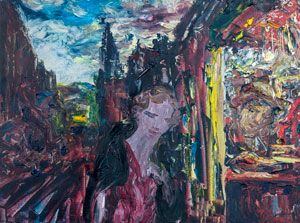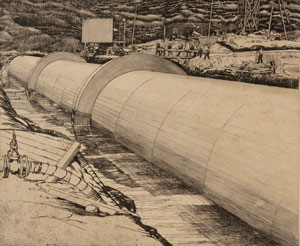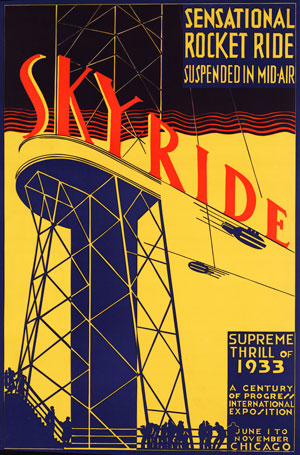‘NO THATCHED COTTAGES’—REPRESENTING THE IRISH FREE STATE AT CHICAGO’S WORLD’S FAIR
Published in Features, Issue 1 (January/February 2023), Volume 31By Billy Shortall

Above: Man Doing Accounts by Jack B. Yeats (1929)—an expressionist, thick-layered painting depicting a modern urban scene. (Private collection)
The 1933–4 Chicago World’s Fair, also known as the Century of Progress Exposition, celebrated the development of Chicago into a modern city. The recently elected Fianna Fáil-led government decided that Ireland should be represented at the spectacle, despite civil servants’ recommendation against participation. They cited the considerable costs involved as an obstacle, but mostly feared that the Irish Free State would not compare well to the modernity exhibited by other participating nations. This exhibition in Chicago was the first transatlantic spectacle in which the new Irish state was represented, and art was central to its display. Reviews of the Irish exhibit in American newspapers identified the contemporary art exhibited as impressive and novel.
The Irish Free State was officially invited to participate in January 1930, and the organisers requested both industrial and cultural displays from the participating nations. The exposition’s focus on technological innovation as progress was reflected in the buildings and architecture of the fair, which were modernist, featuring clean lines and largely unadorned except for some art deco features of bold geometric and symmetrical shapes. An example of this was the monumental Travel and Transport Building—with its suspended roof that expanded and contracted by nearly two metres as the temperature varied—that housed the Irish exhibit. A ‘Sky Ride’ transported visitors across a lake and cars travelled at record speed on specially built motor-circuits.
INITIAL RELUCTANCE TO PARTICIPATE
The Irish Free State had to position itself in the middle of this exciting mêlée and this led to the initial reticence, anxiety and reluctance to participate. Tariffs restricted trade opportunities; there was potential to attract American and diaspora tourists but, as the official report stated, spending this money on advertising in the UK and Europe would show a better return. Nevertheless, a file memo stated that ‘considerations such as those connected with national publicity and prestige might outweigh the more tangible considerations of trading advantage’, an example of what today we would term soft power and cultural diplomacy. Essentially, they were going to show off the state and the development of the country since 1922.
The Irish art exhibited consisted of paintings, works on paper, and arts and crafts items such as stained glass by Harry Clarke Studios and An Túr Gloine, and letterpress books and prints by Cuala Press and Cluna Studios. These exhibits were presented alongside replica pieces from the National Museum and showed modern Irish crafts in a continuum from antiquity. Aligning with the political, it demonstrated that Ireland was not just a new state but also a country with an ancient heritage that had reclaimed her independence. Daniel J. McGrath, Irish consul in Chicago, was commissioner for Irish participation. In a radio interview he said that the contemporary arts and crafts showed the same ‘delicate perfection of execution’ as the older items, examples of ‘genius within the race’.
LITURGICAL ART
About a quarter of the 150 contemporary arts and crafts exhibits—stained glass, needlecraft, processional banners by Gertie Grew and Margaret O’Keefe, vestments by the Dún Emer Guild—were examples of liturgical art. All served to emphasise the distinctiveness of Ireland as the island of saints and scholars, underpinning the country’s historical and contemporary associations with the Catholic Church. Of the other items, many were of neo-Celtic design, with examples of Irish lace and metalwork, and numerous prints of everyday Irish life in a functioning state.
Minister for Industry and Commerce Seán Lemass wrote to Dermot O’Brien, president of the RHA, and stated that a space of ‘1,569 square feet has been reserved for the display of Free State goods … [and that it is] highly desirable that there should be a representative display of pictures by living Irish artists’. Lemass wanted O’Brien, RHA members Leo Whelan and Seán O’Sullivan and ‘an officer of the Department’ to select the artwork for exhibition.
O’Brien requested works from various artists, although several paintings were subsequently rejected for not meeting the criteria mandated by the Department. These criteria stated that work submitted should represent ‘Free State interests’ and added that ‘representations of Irish life as emanating from thatched cottages’ and paintings interpreted as ‘advertising beauty spots in the Six Counties’ were not acceptable. For example, William Conor had two paintings rejected. One depicting ‘an Orange procession’ and another of shipbuilders—which possibly included a detail of a small Union Jack flag—were deemed, ‘in the opinion of the Minister’s representative, not of Free State interest’.
‘POLITICS HAVE INVADED THE REALM OF ART’

Above: Shannon Scheme No. 2: The Culvert, etching on paper by George Atkinson (c. 1930). The country’s most significant industrial project, the Shannon hydroelectric scheme, was documented at the fair in both the industrial and the art exhibits. (Crawford Art Gallery, Cork)
Images of the frugal comforts of life in a thatched cottage, a motif that many artists had used as ‘a virtual icon of Irish rural life’ at this time and before, were thought to represent poverty and lack of progress and were excluded. James Humbert Craig had his painting Muckish, Co. Donegal, which included images of thatched cottages, rejected but he had another work without cottages accepted. O’Brien’s rejection letters stated that he contested the rejections, clearly implying that his hand had been forced by the government.
Many of the rejected artists replied with complaints about the process of the selection committee. Humbert Craig was particularly incensed and complained that the ‘new Government’ should encourage the fine arts ‘instead of using [them] for commercial purposes’. Paul Henry’s A Connemara Lake was accepted, but he expressed dismay that ‘the Minister for Industry and Commerce practically dictated what was to be such and what was not’, adding that his ‘thatched cottages’ were his best sellers in America.
The press reported the controversy; the Irish Independent stated that a ‘certain work of Irish artists non-resident in Ireland was rejected because it did not deal with purely Saorstát subjects’. Northern papers, the Belfast Newsletter and the Daily Mail, were more forthright, and both led with an identical opening sentence—‘Politics have invaded the realm of art’. Back in the RHA, O’Brien speculated that artist William Conor was ‘stirring trouble’ in the press. Both Northern press reports refer to the representative of the Ministry for Industry and Commerce censoring the artwork and excluding paintings ‘which contained a six-county interest’. These reports suggested that Northern artists could be represented in the UK section, but the British didn’t exhibit contemporary art—Ireland led the way with its contemporary art exhibition.
The rejection of work was clearly problematic for artists on the selection committee. It challenged the concept of artistic freedom, and it had the potential to undermine the personal relationships and cultural networks that existed within the larger artistic community of the Free State and beyond. O’Brien mitigated the potential damage in the official rejection letters by identifying the minister’s representative, the anonymous civil servant, as the censor, and by sympathising with the artists.
Despite omitting thatched cottages, many of the paintings exhibited could still be described as conventional views of Irish subject-matter in a realist style. One third were rural scenes, predominantly of the west of Ireland—for example, Portrait of a Connemara Girl and Turf Boat by Charles Lamb, Aran Islands by Brigid O’Brien and Stoney Headland by Power O’Malley.
These were tempered, however, with the inclusion of works by Nano Reid, Mary Swanzy, Margaret Clarke, Jack B. Yeats and others. Yeats’s Man Doing Accounts is an expressionist, thick-layered painting depicting a modern urban scene of a man doing accounts, a fashionable woman on the street and a landscape in the distance. Clarke’s entry, Strindbergian (1927), drew its theme from August Strindberg’s modern drama The Ghost Sonata (1907). The painting is an allegorical meditation on the human condition relocated to an Irish landscape. Ironically, one of Seán Keating’s three exhibits, Homo Sapiens, is a satire on progress—the theme of the fair.
SHANNON SCHEME
The country’s most significant industrial project, the utterly modern Shannon hydroelectric scheme, was documented at the fair in both the industrial and the art exhibits. Both the New York Times and the London Financial Times must have allayed the participation anxieties of Irish officials when they reported on its success and that it signalled a modern, forward-looking nation. George Atkinson showed his officially commissioned etchings of the scheme.
The skilled craftwork, the modernist paintings and the industrial exhibits were representative of a modern Ireland, one that was progressing through industrialisation. The demand that the Irish art exhibits represented Free State interests reflected the political contexts of 1930s Ireland and the rise of nationalism internationally. In this ‘Free State first’ approach, anything that might confer political legitimacy on the six counties as British territory was out. The deliberate actions of the government in excluding images of thatched cottages in rural Ireland—to avoid any suggestions of a lack of progress or poverty or parochial mentalities—is at odds with prevailing historical scholarship on this period, which usually cites Paul Henry’s ‘thatched cottages’ as coinciding ‘with the Free State’s official construct of Ireland’.
The exhibits in Chicago were used to describe an ancient, culturally rich country, the Irish people as distinct, and the Free State as rural yet industrially progressive, Catholic and Gaelic. It did not wish to showcase the myriad of social and economic challenges facing the state. For this event the official version of Irish art and culture was jealously guarded at home by the state and in Chicago by the consul general, McGrath. The Irish Free State carefully constructed an image of itself for its diaspora and a wider American public. These images combined to reflect the progress of the Irish nation since independence, the values of the Irish as an independent people and the aspirations for the future of the new state. In doing this they avoided a backward-looking or thatched-cottage identity. The fair ran again in 1934 but this time the Irish Free State and many other countries declined official participation.
Billy Shortall is the Ryan, Gallagher, Kennedy Research Fellow on the Cuala Press Project at Trinity College Dublin.
Further reading
M.Carew, The quest for the Irish Celt: the Harvard Archaeological Mission to Ireland, 1932–1936 (Newbridge, 2018).
C. Fanning, ‘Duelling cultures: Ireland and Irish America at the Chicago World’s Fairs of 1933 and 1934’, New Hibernia Review 15 (3) (2011), 94–110.
C.R. Ganz, The 1933 Chicago World’s Fair: a century of progress (Urbana, 2008).

















